
An unrelated alternate poster image for "Found In Time"
Sometimes you’re saving money, and sometimes you’re just moving the costs around. How do you tell the difference?
You’ve gone through the budgeting process and delivered a draft that’s over what the producer wants to bring the film in for. So you trim the fat first (an extra shoot day), then some of the muscle (smaller crew), and still you think there are some places to cut. But before you do that, think about whether you’re actually saving money, or just moving the costs somewhere else. Here are some specific examples.
CUTTING SHOOT DAYS
If you can shoot the film in one less day, you’ll obviously save on everyone’s salary, plus equipment and location fees. However, you run the risk of going into overtime on at least one of your remaining days. Plus, you may have turnaround issues – you’ll have to push the call later the next day. I line produced a film a few years ago where the producer insisted on a fifteen-day schedule. The best-case schedule called for eighteen days. After talking with the director and DP about how they wanted to shoot the film, I told the producer that we would end up paying for the lost three days in overtime, but with worse results (since the actors and crew would not be performing at their peak after twelve hours). Lo and behold, when doing the final costs, the overtime (and extra location fees) came out to just one thousand less than if we’d simply had more days. Wow, we saved $1000, but we came out with a worse film.
PA SALARIES
On a shoot with three PAs who are each getting $100/day, the “Set PA” line item for an 18-day shoot will run about $8000, including pickup/return days (plus fringes, if you’re paying them). The producer will then ask, “why are we paying so much for PAs?” Firstly, free PAs are hard working but they can make mistakes, because they’re inexperienced, overeager, and haven’t slept. Secondly, they will grab paying jobs when they can so I’ll spend an inordinate amount of time finding replacements. If you’re making a $50,000 film, you may not have a choice. I didn’t when I made “Found In Time,” and I got very lucky with my PAs. But if you have any kind of budget above $50K, try to find a few bucks to pay at least one key PA.
NO TRUCK/VAN
If your plan is to pick up and drop off your gear every day, you’re either (a) insane or (b) shooting a documentary with no lights. As I’ve ranted in previous blog entries, your equipment will always take up more space than you think. Get a van or a truck and pay for parking.
HAIR/MAKEUP PRECALLS
The idea here is that you call the hair stylists, makeup artists, and cast in early so they can start working. This way the rest of the crew isn’t waiting around for the cast to get ready. A lot of producers are reluctant to do this because your cast and HMU folks may accrue meal penalties and overtime because they started earlier. Sometimes they’re right – having people start fifteen minutes or even 1/2-hour early isn’t going to make enough difference to justify the costs. But if you have all the cast members scheduled for the day, or have a scene with a lot of women in it, having a 1/2-hour or 1-hour precall can keep the rest of the crew from going into overtime.
One can go on and on, but the point is that you need to think through the process of budgeting, so you can be sure that you’re actually saving money rather than shifting costs around – or worse, creating the potential for unaccounted-for-costs.

